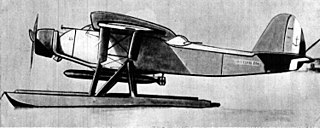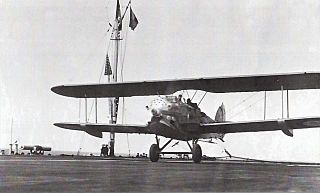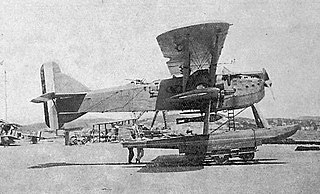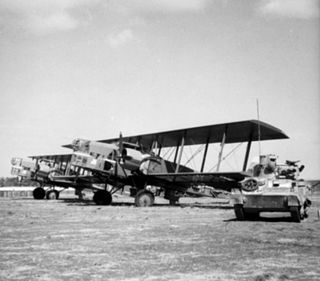
The Gourdou-Leseurre GL-812 HY was a 3-seat reconnaissance floatplane, built by Gourdou-Leseurre.

The Curtiss CR was a racing aircraft designed for the United States Navy in 1921 by Curtiss. It was a conventional single-seater biplane with a monocoque fuselage and staggered single-bay wings of equal span braced with N-struts. Two essentially similar landplane versions were built as the CR-1 and CR-2, which were both eventually converted to seaplanes as the CR-3 in 1923 and CR-4 in 1924. A refined version was developed for the US Army Air Service under the designation R-6. These latter two aircraft featured refined aerodynamics included surface-mounted radiators.

The Levasseur PL.2 was a French biplane torpedo bomber designed by Pierre Levasseur for the French Navy.

The Fokker C.VIII was a reconnaissance aircraft built in the Netherlands in the late 1920s. Intended primarily for the photographic reconnaissance role, it was a larger machine than other Fokker reconnaissance types of the period, with space for a third crew member, who acted as camera operator. It was also Fokker's first aircraft of this type to be built as a monoplane, a parasol wing configuration. The construction, however, was in the familiar Fokker style with wooden wings covered with plywood and fabric, and a steel-tube fuselage, also fabric-covered.

The Latécoère 290 was a torpedo bomber floatplane produced in France during the 1930s. Designed by Latécoère in response to an Aéronavale specification for such an aircraft, the 290 was based on its successful Laté 28.3 mail plane. It was a conventional high-wing, strut-braced monoplane that carried a single torpedo externally under the fuselage.

The Latécoère 380 was a flying boat airplane built in France in 1928 for use on Aéropostale's mail routes to South America. The plane later saw military service as a maritime patrol aircraft.

The Latham 43 was a flying boat bomber built in France in the 1920s for service with the French Navy. It was a conventional design for its day - a two-bay biplane with unstaggered wings, and engines mounted tractor-fashion on struts in the interplane gap. The pilot sat in an open cockpit, with a gunner in an open bow position, and another in an open position amidships.

The Levasseur PL.4, aka Levasseur Marin, was a carrier-based reconnaissance aircraft produced in France in the 1920s. It was a conventional, single-bay biplane that carried a crew of three in tandem, open cockpits. Purchased by the Aéronavale to operate from the aircraft carrier Béarn, it incorporated several safety features in case of ditching at sea. Apart from small floats attached directly to the undersides of the lower wing, the main units of the fixed, tailskid undercarriage could be jettisoned in flight, and the underside of the fuselage was given a boat-like shape and made watertight.

The Levasseur PL.5 was a carrier-based fighter produced in France in the late 1920s, in response to the 1924 AMBC.2 specification issued by the Service Technique de l'Aéronautique (STAé). It was a conventional, single-bay sesquiplane that carried a crew of two in tandem, open cockpits. Like other Levasseur naval designs of the day, it incorporated several safety features in case of ditching at sea. Apart from small floats attached directly to the undersides of the lower wing, the main units of the fixed, tail-skid undercarriage could be jettisoned in flight, and the underside of the fuselage was given a boat-like shape and made watertight.

The Levasseur PL.6 C.2, also known as Levasseur VI C.2, was a two-seat fighter aircraft built in France in 1926 in order to meet a 1925 C.2 Service Technique de l'Aéronautique (STAé) specification,. Constructed along the same lines as Levasseur's naval aircraft of the same era, it was a conventional, single-bay biplane with seating for the pilot and tail gunner in separate, open cockpits. Flight testing of the prototype commenced in 1926, and it was exhibited at the Salon de l'Aéronautique at the end of the year.

The Levasseur PL.7 was a torpedo bomber developed in France in the late 1920s. It was a development of Levasseur's PL.4 reconnaissance aircraft and intended to replace their PL.2 then in service with the Aéronavale. It was a single-bay biplane of largely conventional design, but incorporating safety features for naval operation, including jetissonable main undercarriage units, a watertight, boat-shaped fuselage, and small floats on the undersides of the lower wings.

The Levasseur PL.10 was a carrier-based reconnaissance aircraft developed in France in the late 1920s. It was a conventional, single-bay biplane along similar lines to Levasseur's contemporary designs for the French navy, including a watertight, boat-shaped fuselage, small underwing floats, and undercarriage that could be jettisoned in flight in order to improve the changes of a successful ditching.

The Levasseur PL.14 was a torpedo bomber seaplane developed in France in the late 1920s. It was essentially similar to Levasseur's PL.7 carrier-based reconnaissance aircraft with the addition of pontoons. The design dispensed with the small underwing floats that formed part of the safety equipment of Levasseur's carrier-based aircraft of the period, but retained the boat-like fuselage. The wing was built to the 18.00-metre design originally developed for the PL.7 but ultimately rejected in favour of a shorter wing.

The Lioré et Olivier LeO 25 was a bomber aircraft produced in France in the late 1920s.

The Lioré et Olivier LeO H-43 was a reconnaissance seaplane produced in France in the 1930s. It was a strut-braced, mid-wing monoplane of largely conventional design, provided with an observation balcony underneath the fuselage. It was designed to be launched by catapult from warships and, after a first flight in 1934, trials were conducted on board Commandant Teste.

The Villiers II was a French two-seat fighter aircraft of the 1920s intended for operation from the Aircraft carrier Béarn of the French Navy. It was a single-engined tractor biplane with a waterproof hull in the form of a flying boat to allow the aircraft to be safely landed on water in an emergency. Two prototypes and 30 production aircraft were built, the type serving briefly with the French Navy, although never operated from an aircraft carrier.

The SNCAO CAO.600 was a French prototype twin-engined torpedo-bomber of the Second World War. It was intended to operate from two new aircraft carriers of the French Navy, but only a single example had been completed and flown when the surrender of France in June 1940 ended development of the aircraft.

The Levasseur PL.8 was a single engine, two-seat long-distance record-breaking biplane aircraft modified from an existing Levasseur PL.4 carrier-based reconnaissance aircraft produced in France in the 1920s. Levasseur built the aircraft in 1927, specifically for pilots Charles Nungesser and François Coli for a transatlantic attempt to win the Orteig Prize. Only two examples of the type were built, with the first PL.8-01 named L'Oiseau Blanc, that gained fame as Nungesser and Coli's aircraft.

The Levy Biche LB.2 was a single seat French sesquiplane fighter aircraft designed to be used from aircraft carriers. With a watertight fuselage, jettisonable wheeled undercarriage and small under-wing floats, it could survive emergency sea touchdowns; it could also be fitted with seaplane type floats.

The Levasseur PL.200 was an observation seaplane built by Levasseur in the mid-1930s. It was a high-wing monoplane with a short, all-metal fuselage nacelle at mid-span, and a wing made of metal.




















